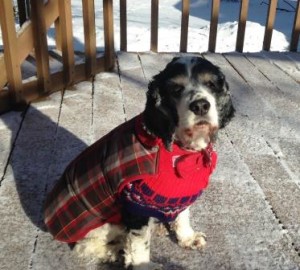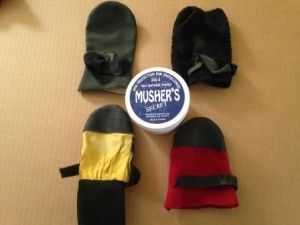You look out the window of your back door through the crust of ice forming around the edges. It’s snowing, blowing hard, and well below freezing outside, but you need to walk your dog. Some people just open the door and tell them to ‘go potty’. Not me. If they have to suffer, so do I. I also want to make sure they cleaned themselves out.
So how can you make your best friend enjoy the winter more? Layering—the same as for us. My rule of thumb is as follows:
- If it’s below 20° then I put coats on my two cocker spaniels. I’ve let their fur grow over the winter, so they usually feel fine above 20°.
- If it’s below 15° then I layer a sweater under their coat.

This works pretty well until their paws touch the first grains of salt lain out by one of our neighbors, or at the park. Usually it’s Buffy. She lifts up one paw and limps awkwardly, with the “Help me, my paws hurt” look. If it’s just a quick walk around the block, and I’m running late, I just force her to keep moving, but I feel guilty. Once we get a few feet past the salted areas, she does fine. Fresh snow and cold temperatures seem to cause much more problems than does older snow or when it is warmer.
If we are going skiing, I have tried booties, not on Buffy, but on my springer, Cassie. She loved to go skiing. Buffy and Chipper are more wimps—preferring to stay inside on cold days. Although there are many kinds of booties, most of which I have tried, all of them collect snow at the top when Cassie would jump into deep snow. After a short time, Cassie would stop and bite at her paws, and I’d have to take off the booties, shake them out, melt the ice balls on her fur, and with frozen fingers, try to put the booties back on—not fun.

Then I found Musher’s Secret, which is a waxy goop I put between their toes. Yes, Cassie still bit her paws some, but putting more wax on her paws was a lot easier than tracking down a bootie and putting it on. It works great! My only advice is that you should put it on just before your dog goes into the snow; it works best then and reduces the area where your dog may leave some waxy residue on your floor, carpet, or car seat.

